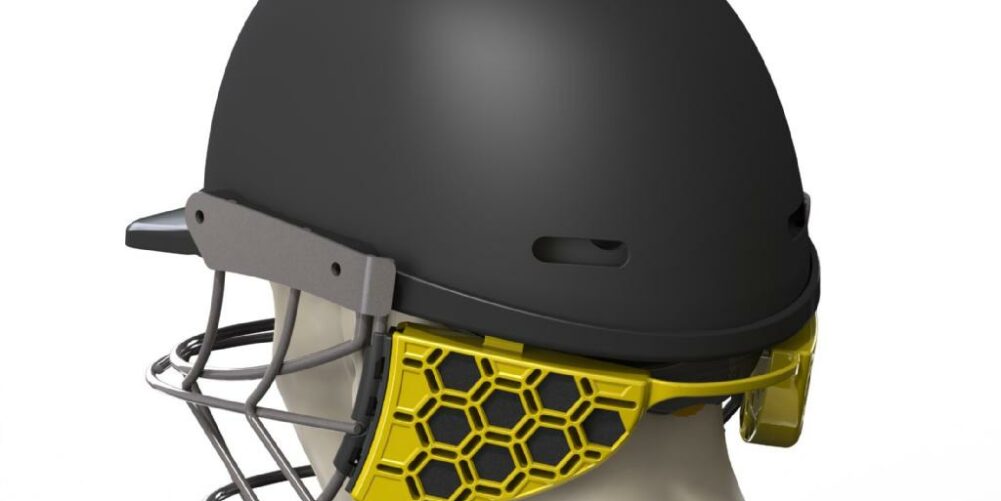While cricket used to be considered ‘a sport for gentlemen played by gentlemen’, more recently it has upped its game to include women’s cricket and devised new formats that are faster and see more action packed into a shorter match. But that extra action means the game has become more aggressive and quicker with bowlers achieving 80mph fire power.
Pads and gloves have been standard equipment at professional and all other levels while helmets are a relatively recent introduction. The first was introduced by Patsy Hedren in the 1930’s but they were not a common sight until the 1970’s.
The ´Masuri Vision Series´ has become the classic protective helmet for cricketers because of its stylish and traditional gladiatorial looks, and its ability to safely decelerate a ball coming from any angle.
Alan Meeks, founder of design consultancy Visitech, helped develop the new Masuri Vision Series helmets in 2011 and has been working on the range ever since. Because of this work cricket has become safer and more enjoyable. He said “Higher levels of protection increase batsmen’s confidence so they can play a better game against more aggressive bowlers.”
Protection Without Compromise
Meeks summed up the technical design challenge for the newest Vision Series helmets. “They have to offer all round protection without compromising vision. The helmet must be light weight, comfortable and slow the ball down to a safe speed within 20mm.”
This can only be achieved using digital 3D simulations Meeks explained, “I use Dassault Systèmes SOLIDWORKS 3D technology to model the helmet and accurately simulate ball-strike impacts.” These models are then deployed as a basis for collaboration. “Because anyone can pan, zoom and rotate the 3D model on any device, even a smartphone, all stakeholders can see the design, understand its protective characteristics and better appreciate the implications of any decisions about its design, manufacture or marketing.”
Meeks uses a bowling machine to verify ball strike analysis. This is calculated using the simulated 3D model against the finished manufactured product. The results he said are, “Totally accurate.”
The application also supports high-end rendering of the 3D models for the creation of hyper-realistic product stills. Meeks said, “When people see these lifelike rendered 3D models they think that it’s a photograph of a finished product.” That is a boon to marketing because using highly realistic product imagery means that more accurate consumer reaction and data on potential acceptance can be gathered. It also helps achieve and share the product’s exact aesthetic including all surface finishes before it is physically produced.”
That’s Not Cricket
3D-printing is very useful to Visitech not just for cricket helmets but also for those devised and produced for a long running sci-fi film series, where a different kind of force is in play, and about which Meeks is sworn to secrecy. These organic shaped helmets that can be seen in the new episode were developed using SOLIDWORKS design application. An exact physical replica was 3D printed from the digital design and used to produce a silicon mould. That was then used to make a complete set of helmets for the film’s actors.
High resolution rendering was also essential for this project. Meeks explained, “In 4K film resolution every detail has to be perfect. Using SOLIDWORKS application is the only way to achieve that level of finish. Millions of people are going to see the movie and it will be shown for decades so it’s got to be right. Seeing digital designs at the highest resolution means I know exactly what the finished helmets will look like on the big screen.”
Back on earth 3D simulation also allows Meeks to further refine Masuri designs. “The relationship between the Masuri Vision’s peak and its metal visor is key to protection without impairing vision or movement. The visor has two bars at the front but because of their position the wearer only sees one. This kind of innovation is made simple with 3D modelling where you can examine the created 3D model from any position, even from the wearer’s point of view, and then use a 3D printer to validate the design.”
Danger Zone
A recent addition to the Vision Series is the ´StemGuard´. This clip-on attachment provides extra protection for the exposed and vulnerable area at the back of the head and neck without restricting movement. This was introduced following the tragic death of Australian Test and One Day International, Philip Hughes. Hughes died when a ball hit his vertebral artery. This is a very rare injury for cricket but since most people would naturally turn away with a fast ball coming at their face this attachment not only appeals to batsmen but also to wicket keepers and fielders in short positions close to the wicket.
Team Players
Visitech has partnered with Dassault Systèmes SOLIDWORKS brand reseller Cadtek Systems for 20 years to provide not only the application itself but also a full support programme that deals with any technical or usage issues. One more long-term partnership is with BM Injection Services, another SOLIDWORKS user providing manufacturing services for the Masuri range.
Visitech designs a wide range of industrial, commercial and consumer products all of them relying on SOLIDWORKS application. Meeks said, “The application allows us to explore ideas and show them immediately to customers then produce physical prototypes that exactly match the digital design. It is a precision modelling tool that allows you to be creative – it’s like a pair of hands and the only way of guaranteeing the all-round quality that is required. And it lets me help people realise their dreams from initial concepts to manufacturable products.”
For further information: http://www.3ds.com/products-services/solidworks













A very good initiative. It will make gentleman game more better.